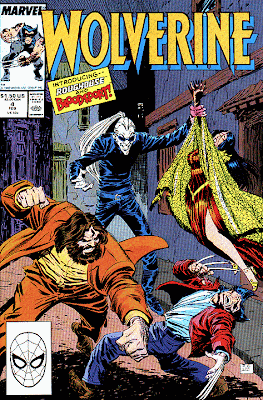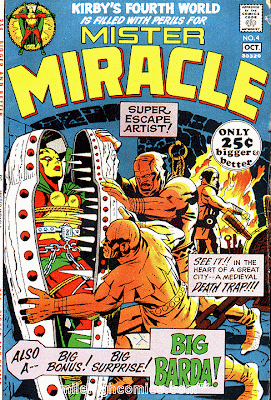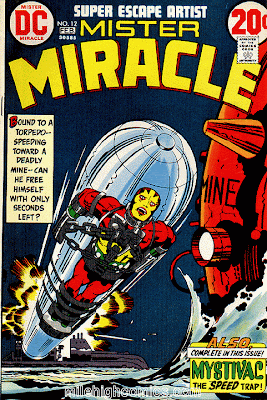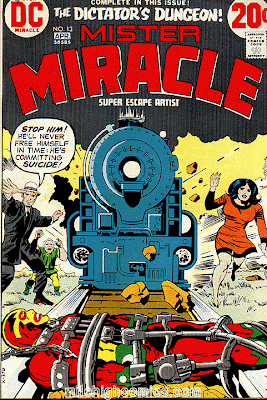Wednesday, December 29, 2010
Saturday, December 25, 2010
Thursday, December 23, 2010
Kirby, Lucas, and Campbell
I was referenced at http://kirbymuseum.org/blogs/dynamics/ regarding the Kirby vs. Lucas debate. Read below and please check out the great site http://kirbymuseum.org/blogs/dynamics/ that Keeps Jack Kirby's brilliance alive!

Thanks to Angelo for his comments on Ronin Ro’s Tales to Astonish book.
The Hero’s journey, a simple movie template.
There are hundreds of articles online if you want to read about George Lucas and Joseph Campbell. Here is an excerpt from one called Star Wars: Origins, by Kristen Brennan, followed by some screen caps of her chart.







I also think George Lucas saw hundreds of television shows, hundreds of motion pictures, hundreds of movie serials; he probably read hundreds of comic books, hundreds of comic strips, and he combined all of these elements into his first script for The Star Wars. The Fighting Devil Dogs films are one possible influence.
Joseph Campbell’s work gave George Lucas a template where he could apply the hero’s journey to his film script. For example, the concept of a son at war with his father is a very common mythological motif. Jack Kirby certainly didn’t create that. I think it’s much more likely that George Lucas and Jack Kirby were both mining the same mythological goldmine.
Here’s an excerpt from the article “Move over, Odysseus, here comes Luke Skywalker” by Steve Persall:

Thanks to Angelo for his comments on Ronin Ro’s Tales to Astonish book.
I read this book recently. A fantastic read that’s quite eye opening and shocking at times. I especially enjoyed the part where Jack Kirby and George Lucas have dinner and Jack tells George about a new story he’s working on, the New Gods. He tells George about Mark Moonrider, the “religious presence” known as The Source, his Dark Father, children separated from fathers at birth and the clash between good and evil etc….the book provides many many more details on this. This lunch took place in 1971/1972…..5-6 years before Star Wars was released. I’m not trying to suggest Lucas ripped off Kirby’s idea but there is no doubt Kirby influenced his epic story heavily.
I don’t have the Ronin Ro book at the moment, I loaned it to another Kirby fan, so I asked Angelo for a little more info on the Kirby/Lucas meeting.
I located my book, the dinner included Roy Thomas, Ed Summer (owner of Supersnipe Comic Emporium in Manhattan) and George Lucas. At this dinner George Lucas was relaying his story for Star Wars in which Roy Thomas noticed it sounded a lot like Jack Kirby’s New Gods. In the book, it starts on the first paragraph (middle of the page) on page 199 and continues to page 200. What I took away from this part of the book was that (in my opinion) George Lucas is hugely indebted to Jack Kirby for Star Wars. To me, there are simply too many parallels at the core of the Star Wars story.
Thanks to Angelo for the comment. Believe it or not among some hardcore Kirby fans the Kirby/Lucas debate is pretty contentious. I’m only going to say a few things because we may never really know for sure what exactly took place. And to everyone reading this, please understand I’m just giving my opinion, so don’t take my comments personally. I’ve encountered some people over the years who get very upset when I talk about this topic, especially Kirby fans who despise George Lucas because he’s rich and famous, but I enjoy talking about this subject, so here goes… Like most debates, there seems to be two camps on this topic, the conservative point of view and the liberal point of view. I hate labels because they’re always imperfect, but I’ll call it the Kirby critics versus the Kirby purists.
I find that even Kirby’s harshest critics tend to agree Jack Kirby was one of George Lucas’ influences. Lucas admits that he read comic books, and I recall a quote where Lucas says he was familiar with Jack Kirby’s comics. Even people who hate Jack Kirby with a passion are still willing to admit surely Kirby must have been one of the influences on Star Wars – but the Kirby critics main contention is that Jack Kirby is not the pivotal, foundational influence for the Star Wars series, but simply one in a thousand. Seems reasonable, right?
On the other hand you have a very small group of what I call Kirby purists — they suggest that Jack Kirby’s fourth world series was the single most important influence on the first Star Wars movie. George Lucas was so embarrassed by this fact afterwards, he invented a false backstory: after the Star Wars movie was released, George Lucas pretended that he read Joseph Campbell’s Hero With a Thousand Faces in order to hide his true influence (Kirby and comics). This theory is based on a Salon article called “Galactic Gasbag” (2002).
Here’s my take on this: although I usually disagree with them on many topics, I have to side with the Kirby critics on this one. Attacking George Lucas and accusing him of lying about reading Joseph Campbell’s book seems rather extreme to me — and quite frankly silly unless there’s some evidence. Surely it’s possible George Lucas read Joseph Campbell’s Hero With a Thousand Faces when he was in film school? Maybe someone remembers George Lucas reading the book and that would put the Joseph Campbell conspiracy theory to rest?
I’m not an expert on the subject by any stretch of the imagination (I enjoyed the first Star Wars film, but I found the other five sort of disappointing, and I haven’t really read any of the Star Wars comic books or novels), but quickly: here’s what I think about the Jack Kirby/George Lucas connection based on some reading on the subject, discussing this with some of the experts, and several off the record conversations on the topic.
I think George Lucas read Hero With a Thousand Faces before he made the Star Wars movie. I just don’t see any reason not to believe Lucas on this.
The Hero’s journey, a simple movie template.
There are hundreds of articles online if you want to read about George Lucas and Joseph Campbell. Here is an excerpt from one called Star Wars: Origins, by Kristen Brennan, followed by some screen caps of her chart.
Kristen Brennan: Lucas had already written two drafts of Star Wars when he rediscovered Joseph Campbell’s The Hero With a Thousand Faces in 1975 (having read it years before in college). This blueprint for “The Hero’s Journey” gave Lucas the focus he needed to draw his sprawling imaginary universe into a single story. Note that the Wachowski Brothers’ wonderful film The Matrix is carefully built on the same blueprint.”








I also think George Lucas saw hundreds of television shows, hundreds of motion pictures, hundreds of movie serials; he probably read hundreds of comic books, hundreds of comic strips, and he combined all of these elements into his first script for The Star Wars. The Fighting Devil Dogs films are one possible influence.
Joseph Campbell’s work gave George Lucas a template where he could apply the hero’s journey to his film script. For example, the concept of a son at war with his father is a very common mythological motif. Jack Kirby certainly didn’t create that. I think it’s much more likely that George Lucas and Jack Kirby were both mining the same mythological goldmine.
Here are a few more influences on Star Wars posted by Miss Cellania on neatorama.
Here’s an excerpt from the article “Move over, Odysseus, here comes Luke Skywalker” by Steve Persall:
Steve Persall: Campbell defined the Hero Cycle, a course of events that occurs as a rite of initiation in every myth, pinpointing the need for mentors, villains, elixirs and jesters along the way. Each step can be traced in the adventures of Star Wars hero Luke Skywalker. Before Campbell died in 1987, the scholar and Lucas became friends. A storyteller needs a mentor as much as a hero does. “Yes, I consider him a mentor,” Lucas said at a recent New York press conference. “He was an amazing scholar and an amazing person. When I started doing Star Wars, I re-read Hero with a Thousand Faces. After Return of the Jedi, somebody gave me a tape of one of his lectures. I was just blown away by that. He was much more powerful as a speaker than he was as a writer.”A short time later, Lucas loaned his studios to PBS to produce the Campbell series. Letters and gifts exchanged by the two visionaries are on display in the Joseph Campbell Archives in Santa Barbara, Calif. The founding curator of that museum, Dr. Jonathan Young, said Campbell compared Lucas to the masters. “Campbell was very grateful that Lucas presented the elements of Luke’s initiation so clearly,” Young said. “The idea of a calling, of being drawn away into a place of wisdom, finding allies and mentors, accomplishing the ordeals, and then returning.” In Campbell’s teachings, myths inspire both awe and recognition. They communicate a sense of universal order and show how people should live.
Saturday, December 11, 2010
Thursday, December 9, 2010
New Thor Movie Poster!
Fans anticipating the release of “Thor” on May 6, 2011–and really, who isn’t?–have reason to rejoice with the debut of this one-sheet for the film featuring the Thunderer himself in all his glory!
But that’s not all we have planned for you, Marvelite! Come back to this page tomorrow at 7:00 pm ET for the premiere of Thor’s first trailer! The trailer will play in select theaters this weekend, you might even catch it in 3D!
Now feast your eyes on the amazing “Thor” one-sheet, and check back tomorrow to see Chris Hemsworth show his stuff as the mighty hero we all know and love.
In addition to “Thor,” Marvel Studios will release a slate of films based on the Marvel characters including “Captain America: The First Avenger” on July 22, 2011; “Marvel Studios’ The Avengers” on May 4, 2012; and “Iron Man 3″ on May 3, 2013.
Wednesday, November 24, 2010
Sunday, November 21, 2010
Friday, November 19, 2010
Tuesday, November 16, 2010
Hulk #181 the First Appearance of Wolverine?
Wolverine first appeared in the final "teaser" panel of The Incredible Hulk #180 (cover date October 1974) written by Len Wein and penciled by Herb Trimpe. The character then appeared in a number of advertisements in various Marvel Comics publications before making his first major appearance in The Incredible Hulk #181 (cover date November 1974) again by Wein and Trimpe.
Saturday, November 13, 2010
Mister Miracle Bio and Comic Covers
Mister Miracle was one of four series in Kirby's ambitious but short-lived Fourth World saga. The character was inspired by the early illusionist career of comic book artist Jim Steranko, while the character's relationship with Big Barda is based on Kirby's relationship with his own wife.
Thaddeus Brown was a circus escape artist whose stage name was Mister Miracle. As the first escape artist to use the name Mister Miracle, Brown mentored both Scott Free and Shilo Norman. After Brown's murder, Scott Free took up the Mister Miracle name, adopted Thaddeus' young ward Shilo Norman, and hired his assistant Oberon.
Scott Free is the son of Izaya (Highfather), the ruler of New Genesis, and his wife named Avia. However, as part of a diplomatic move to stop a destructive war against the planet Apokolips, Highfather agreed to an exchange of heirs with the galactic tyrant Darkseid; the exchange of heirs guaranteed that neither side would attack the other. Scott traded places with Darkseid's second born son Orion.
Scott grew up in one of Granny Goodness' "Terror Orphanages" with no knowledge of his own heritage. As he matured, Scott rebelled against the totalitarian ideology of Apokolips. Hating himself for being unable to fit in, he was influenced by Metron to see a future beyond Darkseid. Scott became part of a small band of pupils who were tutored in secret by the rebel Himon, a New Genesian living as a "Hunger Dog" on Apokolips. It was at these meetings that he met fellow pupil Big Barda, who would later become his wife.
Eventually, Scott Free escaped and fled to Earth. His escape, long anticipated and planned for by Darkseid, nullified the pact between Darkseid and Highfather and gave Darkseid the excuse he needed to revive the war with New Genesis. Once on Earth, he became the protégé of a circus escape artist, Thaddeus Brown, whose stage name was Mister Miracle. Brown was impressed with Scott's skills (especially as supplemented with various advanced devices he had taken from his previous home). Scott also befriended Brown's assistant, a dwarf named Oberon. When Thaddeus Brown was murdered, Scott Free assumed the identity of Mister Miracle. Barda later followed Scott to Earth, and the two used their powers, equipment, and skills in the war against Darkseid, who was still interested in recapturing both of them. Eventually, tired of being chased on Earth by Darkseid's servants, Scott returned to Apokolips and won his freedom by legal means, through trial by combat.
Scott Free later became a member of the Keith Giffen-era JLA (as did Barda and Oberon), which recast him and Big Barda as semi-retired super-heroes that sought to live quiet lives in the suburbs when they were not involved in Justice League-related adventures. In particular, Scott Free was recast as a hen-pecked husband, who often found himself on the receiving end of his wife's temper, over her desire to live a quiet life on Earth.
During his time in the League, Scott developed an intense rivalry with League villain Manga Khan. The villainous intergalactic trader and black marketer repeatedly kidnapped Scott, ultimately convincing Scott's conniving former manager Funky Flashman into forging documents forcing Scott to work for Manga as his personal entertainer. To force him to go along willingly, Khan replaced Scott with a life-like robot who was ultimately murdered by Despero during his first mission with the Justice League. Scott ultimately escaped from Manga Khan's clutches and reunited with his wife and friends, though the shock was enough to cause Scott to ultimately quit the League and to take on a protege in the form of Shiloh Norman.
In the conclusion of Final Crisis, many of the New Gods are all seemingly reborn. Among their numbers are the apparently resurrected Mister Miracle, along with Barda.
Young Shilo Norman was the informal ward of escapologist Thaddeus Brown (Mister Miracle I), and he also served as an occasional stand-in. When Brown was murdered by a mobster named Steel Hand, Scott avenged his new friend's death by taking on the identity of Mister Miracle and brought Steel Hand to justice. After Brown's death, Shilo worked with Scott Free (the new Mister Miracle) and Scott's wife Barda.
A master escape artist himself, the now-adult Shilo was appointed security chief of the Slabside Island Maximum Security prison for Metahumans also known as the Slab. He held his own during the Joker's "Last Laugh" riot and was promoted to Warden of the Slab, which had by then been relocated to Antarctica. A somewhat re-conceived Shilo Norman appears in Grant Morrison's Seven Soldiers crossover. In Final Crisis #2, Shilo tells Sonny Sumo,"There was a cosmic war and the powers of evil won", prompting him to form a team to fight the evil gods.
Thaddeus Brown was a circus escape artist whose stage name was Mister Miracle. As the first escape artist to use the name Mister Miracle, Brown mentored both Scott Free and Shilo Norman. After Brown's murder, Scott Free took up the Mister Miracle name, adopted Thaddeus' young ward Shilo Norman, and hired his assistant Oberon.
Scott Free is the son of Izaya (Highfather), the ruler of New Genesis, and his wife named Avia. However, as part of a diplomatic move to stop a destructive war against the planet Apokolips, Highfather agreed to an exchange of heirs with the galactic tyrant Darkseid; the exchange of heirs guaranteed that neither side would attack the other. Scott traded places with Darkseid's second born son Orion.
Scott grew up in one of Granny Goodness' "Terror Orphanages" with no knowledge of his own heritage. As he matured, Scott rebelled against the totalitarian ideology of Apokolips. Hating himself for being unable to fit in, he was influenced by Metron to see a future beyond Darkseid. Scott became part of a small band of pupils who were tutored in secret by the rebel Himon, a New Genesian living as a "Hunger Dog" on Apokolips. It was at these meetings that he met fellow pupil Big Barda, who would later become his wife.
Eventually, Scott Free escaped and fled to Earth. His escape, long anticipated and planned for by Darkseid, nullified the pact between Darkseid and Highfather and gave Darkseid the excuse he needed to revive the war with New Genesis. Once on Earth, he became the protégé of a circus escape artist, Thaddeus Brown, whose stage name was Mister Miracle. Brown was impressed with Scott's skills (especially as supplemented with various advanced devices he had taken from his previous home). Scott also befriended Brown's assistant, a dwarf named Oberon. When Thaddeus Brown was murdered, Scott Free assumed the identity of Mister Miracle. Barda later followed Scott to Earth, and the two used their powers, equipment, and skills in the war against Darkseid, who was still interested in recapturing both of them. Eventually, tired of being chased on Earth by Darkseid's servants, Scott returned to Apokolips and won his freedom by legal means, through trial by combat.
Scott Free later became a member of the Keith Giffen-era JLA (as did Barda and Oberon), which recast him and Big Barda as semi-retired super-heroes that sought to live quiet lives in the suburbs when they were not involved in Justice League-related adventures. In particular, Scott Free was recast as a hen-pecked husband, who often found himself on the receiving end of his wife's temper, over her desire to live a quiet life on Earth.
During his time in the League, Scott developed an intense rivalry with League villain Manga Khan. The villainous intergalactic trader and black marketer repeatedly kidnapped Scott, ultimately convincing Scott's conniving former manager Funky Flashman into forging documents forcing Scott to work for Manga as his personal entertainer. To force him to go along willingly, Khan replaced Scott with a life-like robot who was ultimately murdered by Despero during his first mission with the Justice League. Scott ultimately escaped from Manga Khan's clutches and reunited with his wife and friends, though the shock was enough to cause Scott to ultimately quit the League and to take on a protege in the form of Shiloh Norman.
In the conclusion of Final Crisis, many of the New Gods are all seemingly reborn. Among their numbers are the apparently resurrected Mister Miracle, along with Barda.
Young Shilo Norman was the informal ward of escapologist Thaddeus Brown (Mister Miracle I), and he also served as an occasional stand-in. When Brown was murdered by a mobster named Steel Hand, Scott avenged his new friend's death by taking on the identity of Mister Miracle and brought Steel Hand to justice. After Brown's death, Shilo worked with Scott Free (the new Mister Miracle) and Scott's wife Barda.
A master escape artist himself, the now-adult Shilo was appointed security chief of the Slabside Island Maximum Security prison for Metahumans also known as the Slab. He held his own during the Joker's "Last Laugh" riot and was promoted to Warden of the Slab, which had by then been relocated to Antarctica. A somewhat re-conceived Shilo Norman appears in Grant Morrison's Seven Soldiers crossover. In Final Crisis #2, Shilo tells Sonny Sumo,"There was a cosmic war and the powers of evil won", prompting him to form a team to fight the evil gods.
Subscribe to:
Posts (Atom)
















































































